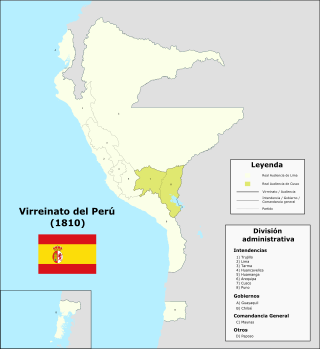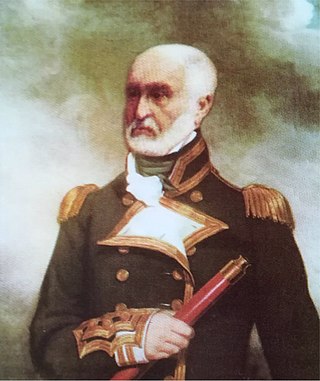
The Basilica Cathedral of Arequipa is located in the "Plaza de Armas" of the city of Arequipa, province of Arequipa, Peru. It is the most important Catholic church of the city and also of the larger Roman Catholic Archdiocese of Arequipa since it is the base of the archbishop and the metropolitan council. The cathedral is also considered one of Peru's most unusual and famous colonial cathedrals since the Spanish conquest.

The Peruvian War of Independence was a series of military conflicts in Peru from 1809 to 1826 that resulted in the country's independence from the Spanish Empire. Part of the broader Spanish American wars of independence, it led to the dissolution of the Spanish Viceroyalty of Peru.

Juan Pío Camilo de Tristán y Moscoso was a Peruvian general and politician who served as the second President of South Peru from October 12, 1838 to February 23, 1839. He was nominally the last viceroy of Peru, serving in that capacity from December 9 to December 30, 1824, but not exercising power.

The Real Audiencia of Quito was an administrative unit in the Spanish Empire which had political, military, and religious jurisdiction over territories that today include Ecuador, parts of northern Peru, parts of southern Colombia and parts of northern Brazil. It was created by Royal Decree on 29 August 1563 by Philip II of Spain in the city of Guadalajara. It ended in 1822 with the incorporation of the area into the Republic of Gran Colombia.

The Roman Catholic Archdiocese of Arequipa is an archdiocese located in the city of Arequipa in Peru. It was erected by Pope Gregory XIII on 15 April 1577 at the request of King Philip II of Spain.

José Manuel de Goyeneche y Barreda, 1st Count of Guaqui was a Spanish soldier and diplomat.

The Army of the North, contemporaneously called Army of Peru, was one of the armies deployed by the United Provinces of the Río de la Plata in the Spanish American wars of independence. Its objective was freeing the Argentine Northwest and the Upper Peru from the royalist troops of the Spanish Empire. It was headed by Hipólito Vieytes (1810), Juan José Castelli (1810–1811), Juan Martín de Pueyrredón (1811–1812), Manuel Belgrano (1812–1814), José de San Martín (1814), José Rondeau (1814–1816), Manuel Belgrano (1816–1819) and Francisco Fernández de la Cruz (1819–1820).
The Royal Governor of Panama ruled over the Spanish colonial administrative district known first as the colony of Darién and later as the colony of Castilla de Oro, which in 1529 was renamed Panamá. This district was subordinated to the Viceroyalty of New Granada on August 20, 1739. There were 113 such governors or presidents during the Spanish conquest and the later periods of Spanish-centered colonialism.

The Protectorate of Peru, also known as the Protectorate of San Martín, was a protectorate created in 1821 in present-day Peru after its declaration of independence from the Spanish Empire. The protectorate existed for one year and 17 days under the rule of José de San Martín and Argentina.
The Cuzco Rebellion of 1814 was an episode of the Peruvian War of Independence led by the Angulo brothers and Mateo Pumacahua that took place in much of the province of Cuzco, including Huamanga, Arequipa and Puno, as well as part of the province of Charcas. The uprising involved the proclamation of the autonomy and self-government of Cuzco from the Viceroyalty of Peru, governed by Viceroy José Fernando de Abascal y Sousa. The junta was modelled and intended to follow the steps of the Junta of Buenos Aires.

The Intendancy of Trujillo, also known informally as Trujillo Province, was one of the territorial divisions of the Viceroyalty of Peru. This territory was ruled from the city of Trujillo, located in La Libertad Region. It was created in 1784 and lasted until 12 February 1821 when General Jose de San Martin created the Department of Trujillo through the Reglamento Provisional to replace it in the new Republic of Peru.

The Peruvian Civil War of 1843–1844 was the second internal conflict in 19th century Peru. It was fought between the government forces of Vivanco and Echenique against the revolutionaries led by Domingo Nieto and Ramon Castilla. A battle was fought at Pachia in Tacna on August 29, 1843. A clash occurred at San Antonio, Moquegua on October 27, 1843. Domingo Nieto died on February 17, 1844. From June 17 to June 29, 1844, fighting occurred in the capital Lima between the government and supporters of Domingo Elías. A final clash occurred at Carmen Alto on July 22, 1844.

Juan Mariano de Goyeneche y Gamio, 3rd Count of Guaqui, was a Peruvian diplomat and politician.
Domingo Pantaleón Tristan y Moscoso was a Peruvian general and politician.
Leandra Josefa Victoria Tristán y Flores del Campo was the First Lady of Peru from 1851 to 1855, during her marriage to the President of Peru, José Rufino Echenique. The district of La Victoria in Lima was named in her honor.

Manuel Ruiz Urriés de Castilla, I Count of Ruiz de Castilla, was a brigadier of the Royal Army of Spain and a public official of the Spain crown in South America. He held the positions of Mayor of the Mines of Huancavelica, Governor General of Cuzco, and President of the Real Audiencia of Cusco (1793–1806) and of the Real Audiencia of Quito (1807–1812).

The Intendancy of Huamanga, also known informally as Huamanga Province, was one of the territorial divisions of the Viceroyalty of Peru, ruled from the city of Guamanga and under the jurisdiction of the Bishopric of Huamanga. It was created in 1784 and was the site of the Battle of Ayacucho, a decisive moment in the Peruvian War of Independence that ended the viceroyalty's existence. It was ultimately replaced by the Department of Ayacucho in 1825.

The Intendancy of Arequipa, also known informally as Arequipa Province, was one of the territorial divisions of the Viceroyalty of Peru, ruled from the city of Arequipa and under the jurisdiction of the Bishopric of Arequipa. It existed from 1784 to 1824, receiving the news of the result of the Battle of Ayacucho in late December of the same year.














